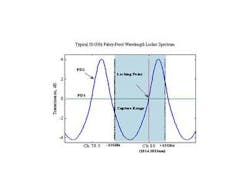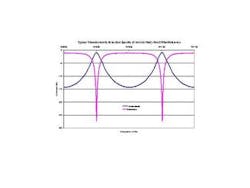Application of Fabry-Perot interferometry in frequency control and stabilization
By DR. PEY-SCHUAN JIAN and PEITI SU, Fibera--The advent of DWDM and erbium-doped fiber amplifiers significantly increased the transmission capabilities of optical fiber, while reducing the cost per bit. DWDM is an important innovation in optical networking because it provides flexibility and scalability, filling the useful optical spectrum in the C-band alone with 40+ channels at 100-GHz spacing, or 80+ channels at 50-GHz spacing, on the same fiber-optic waveguide.
To make DWDM networks fully flexible and ultimately re-configurable, various tunable technologies are emerging to enable transmitters to switch from one channel to the other. During such switching, a crystal equivalent of frequency, similar to radio communications, is established to specify and lock transmitters to specific grids.
As the need for more communication channels arises, frequency stabilization assumes greater significance because channel spacing is narrower and interference between wavelengths must be minimized. Frequency stabilization enables laser transmitters in DWDM systems to lock to international standardized channels. When frequency stabilization is employed, it ensures reliability, enabling network operators to use DWDM with confidence, knowing that a transmitting laser will not interfere with other wavelengths.
Due to the periodic nature of Fabry-Perot interferometry, Fabry-Perot etalon-based devices are ideally suited to wavelength locking for DWDM system lasers. Fabry-Perot etalon-based wavelength lockers have been used in long haul and metro applications to achieve more reliable results. In addition to wavelength lockers, optical filters and references using Fabry-Perot interferometry technology to provide periodic narrow passbands in both transmission and reflection modes serve as key components in calibration, control, and stabilization of tunable components and test instruments.
Frequency stabilization
In the DWDM system, it is essential that the signal wavelengths are aligned to the International Telecommunication Union (ITU) grid and do not drift over the lifetime of the product. This is achieved by using a well-defined and stabilized laser source together with a wavelength locker to stabilize the wavelength to within a few picometers of the ITU grid.
The Fabry-Perot etalon-based wavelength locker has established itself as the stabilizing module for DWDM laser frequency locking to multiple ITU wavelengths. As shown in the Figure above, the wavelength locker receives the input beam, which passes through a beam splitter and is separated into a reference beam and a transmitted beam. The reference beam is received by photodiode 1 (PD1) whereas the transmitted beam passes through a Fabry-Perot etalon and is received by photodiode 2 (PD2). The ideal locking point is when PD1 is equal to PD2 with the shaded area indicating the capture range.
Alignment and thermal stability of the wavelength locker are critical to maintaining the accuracy of the laser. It is generally accepted that for systems with 50-GHz spacing, ±1.25 GHz wavelength stability is required.
In all the Fabry-Perot interferometer applications, maintaining stability over environmental changes is the key behind its accuracy. Recent component and manufacturing process advancement has enabled these devices to be kept to within ±1.25 GHz accuracy in 0 to 70ºC operating and -40º to 85ºC in-storage environmental conditions throughout the devices' lifetime
The lifetime of the fiber-optic components is typically specified as 25 years with 0 to 70ºC operating and -40˚ to 85ºC in-storage environmental conditions. Careful selection of components to make an external locker athermal is crucial if it is to withstand these harsh conditions and still operate within specifications.
Fabry-Perot wavelength lockers can be manufactured in both a standalone (external) hermetic package or as an integrated (internal) sub-assembly mounted inside a hermetically sealed laser module. The external wavelength obtains the most stable laser frequency. With an external wavelength locker, one can expect < 0.1-GHz stability over the entire operating temperature range (0-70°C). Other advantages of an external device include athermal properties and elimination of electronics/firmware compensation. An external wavelength locker also ensures that the servo loop is operating on the most linear portion of the fringe response.
Recently there has been growing interest from transmitter module manufacturers in integrating wavelength locking functionality into their systems. Internal versions lend themselves to the purpose by virtue of compact size and elimination of active mechanical alignment during the manufacturing process. These devices can integrate into any tunable system with a temperature-controlled approach, and they simplify the manufacturing process leading to higher yield and cost reduction.
ITU filter/reference applications
Due to this technology's athermal property and ability to precisely generate periodic spectrum, Fabry-Perot etalon-based wavelength filters can be designed to match any specified free spectral range with varying sharpness. The fringe patterns are aligned to the ITU grid, covering all available channels of the network. Because these filters are compact and do not need any active control, they offer many useful functions for wavelength calibration and stabilization.
A Fabry-Perot ITU filter provides a transfer function that has periodic passbands with 200-, 100-, 50- or 25-GHz channel spacing. It can be used for any application where a stable reference is needed.
These filters are especially appealing to subsystem and system vendors because they are built into a simple DWDM emulator for testing purposes or into network monitoring equipment to track performance. Fabry-Perot ITU filters can also be used to set ITU stops in tunable lasers and tunable filters by providing narrow, accurate, and periodic signals of set free spectral ranges.
With modern technology and manufacturing techniques, the filter's sharp transmission peaks can be aligned to the target wavelengths to within ±1.25 GHz accuracy. The thermal stability of the filter is critical, since the optical path cannot be a function of the temperature. The interferometer components, therefore, need to be carefully selected to meet the athermal criteria.
Remote monitoring and sensing
While the Fabry-Perot interferometer provides periodic transmission and reflection features at the ITU grid that make it ideal for use in fiber-optic communications, with proper design, the transmission peak or the reflection trough can be aligned to any customized bandwidth and channel spacing. Thanks to recent advances in manufacturing processes and in components to enable precise alignment to locking positions and optimal thermal stability, the Fabry-Perot interferometer has uses for frequency control and stabilization in a wide range of other applications such as instrument calibration and remote sensing.
Reflection signals from Fabry-Perot interferometers can be made into a separate referencing and calibration device. This device generates sharp, accurate, and periodic notches evenly spaced with the troughs aligned to the calibration wavelengths so the user knows precisely the offset and errors of the instrument, such as an optical spectrum analyzer (OSA). For instance, if the notches are calibrated to the ITU grid and, at channel 40 (194000 GHz) the curser of the OSA shows 194009 GHz, then the calibration offset of the OSA is +9 GHz. It thus functions as an "optical ruler" to find the errors and help calibrate the instrument.
Precise wavelength measurement is also imperative in any fiber-Bragg grating (FBG) monitoring system. The basic principle of an FBG-based sensor system lies in the monitoring of the wavelength shift in the returned Bragg signals as functions of the strain, temperature, and the force of the system. However, most common tunable devices used in FBG sensing systems such as tunable lasers and/or filters exhibit serious hysteresis and thermal drift among other problems. These limiting factors adversely affect the ability of these sensing systems to produce accurate and repeatable wavelength measurement data. Recently, custom-made Fabry-Perot filters, with free spectral ranges matching the standard FGB sensor wavelength spacing, were used as a wavelength reference in these sensing applications, resulting in significant improvement in overall wavelength measurement accuracy. This technology can be tailored to many specific applications including civil, chemical, and biomedical sensing.
Dr. Pey-Schuan Jian is senior product development engineer, and Peiti Su is operations manager at Fibera, Inc. (Santa Clara, CA). They can be reached at (408) 492-9555 or [email protected].

